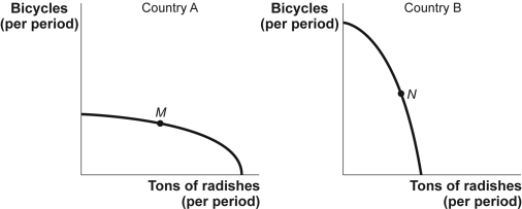Use the following to answer questions :
Figure: Bicycles and Radishes I 
-(Figure: Bicycles and Radishes I) Look at the figure Bicycles and Radishes I. It shows production possibility frontiers for two countries that produce only radishes and bicycles. The axes of the two graphs are measured in equivalent units. Country A is operating at point M, and country B is operating at point N. Suppose country A discovers a new technology that greatly increases its ability to produce bicycles but has no effect on its ability to produce radishes. This would:
Definitions:
Consumption Level
The total amount of goods and services that an individual or group consumes over a specific period.
Technological Improvement
Innovations and advancements in technology that enhance productivity, efficiency, and quality of goods and services.
Production Possibilities Frontier
A curve depicting all maximum output possibilities for two goods, given a set of inputs, representing the trade-offs in production choices.
Economic Questions
Fundamental questions that societies address regarding allocation of resources and distribution of goods and services; typically includes "what to produce," "how to produce," and "for whom to produce."
Q13: The point at which the axes of
Q31: According to the infant industry argument, import
Q43: As long as people have different _,
Q90: The BEST example of making a choice
Q194: A two-year-old child is eating raisins one
Q228: France and the United Kingdom both produce
Q231: (Table: Wheat and Aluminum) Look at the
Q247: (Table: Production of Good Z and Good
Q248: Which of the following best describes demand?<br>A)A
Q267: If the demand for tires goes down